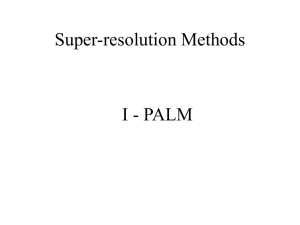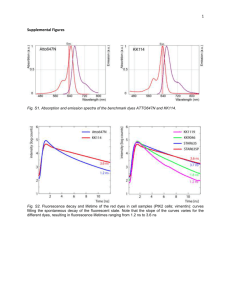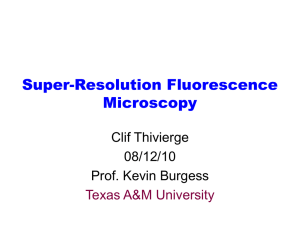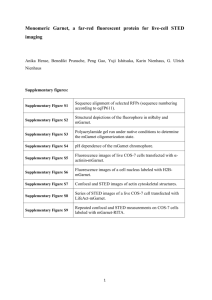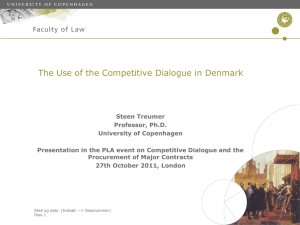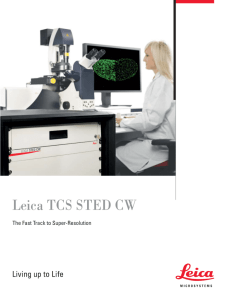STED_Construction_Supplements_RSI_Revision
advertisement
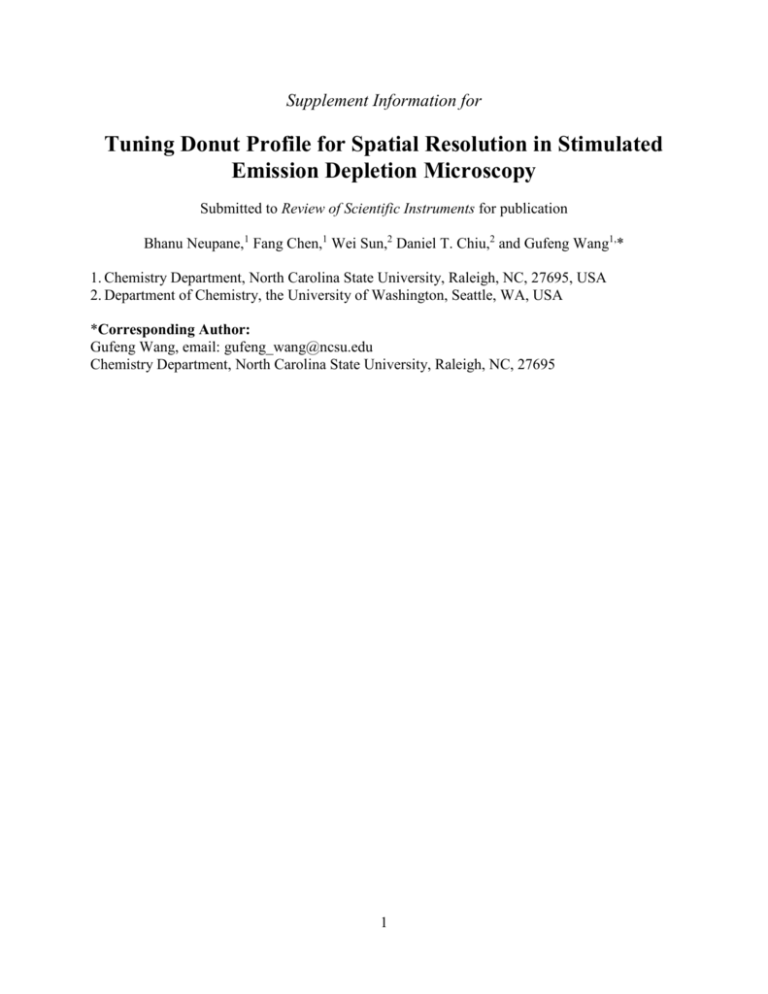
Supplement Information for Tuning Donut Profile for Spatial Resolution in Stimulated Emission Depletion Microscopy Submitted to Review of Scientific Instruments for publication Bhanu Neupane,1 Fang Chen,1 Wei Sun,2 Daniel T. Chiu,2 and Gufeng Wang1,* 1. Chemistry Department, North Carolina State University, Raleigh, NC, 27695, USA 2. Department of Chemistry, the University of Washington, Seattle, WA, USA *Corresponding Author: Gufeng Wang, email: gufeng_wang@ncsu.edu Chemistry Department, North Carolina State University, Raleigh, NC, 27695 1 1. Supplementary Figure Supplementary Figure S1. Donut and cross section profile of obtained by imaging 18 nm polymer particles. Donut beam size at the objective back aperture is ~6.5 mm so that back aperture is slightly over filled. Blue curve represents the fit to the center portion of donut with a parabolic function of slope of 9.0 ×10-5 nm-2. 2 2. Theory 2.1. Point spread function (PSF) and STED resolution In confocal microscopy, the spatial resolution is determined by the confocal PSF, which is the convolution of the excitation PSF and the detection PSF: PSFConfocal ( x, y ) PSFExc ( x, y ) PSFDet ( x, y ) (S1) In practice, the size of the detection PSF is usually larger than the excitation PSF. So the confocal spatial resolution is determined by the excitation PSF. Similarly, STED PSF is determined by the spatial excited state population distribution profile, which is the product of the excitation PSF and the depletion probability: PSFSTED PSFExc ( x, y ) Pr( x, y ) (S2) The depletion probability is a function of the excitation and the depletion laser power. The theoretical STED PSF can be obtained by solving coupled differential kinetic rate equations at each position in the focal plane.1 Under continuous wave (CW) excitation/depletion conditions, the system can be viewed as in steady-state. The rate of the population change at a particular energy level Ei (i = 0, 1, 2, 3) is zero. Considering a 4-state system (as shown in Supplementary Figure S2), the equations can be setup according to the 1994 paper:1 dn0 1 (S3) 0 h( x, y) exc abs (n1 n0 ) n3 dt vib dn1 1 (S4) 0 h( x, y) exc abs (n0 n1 ) n1 dt vib dn2 1 1 0 n1 h( x, y ) sted sted (n3 n2 ) ( Q)n2 (S5) dt vib fl dn3 1 1 0 h( x, y ) sted sted (n2 n3 ) ( Q)n2 n3 (S6) dt fl vib where n is the number of molecules; t is time (s); σabs and σsted are the absorption and stimulated emission depletion cross sections (cm2), respectively; τfl and τvib are the fluorescence and vibrational relaxation times (s), respectively; h(x,y)exc and h(x,y)sted are the excitation and depletion intensities (#/cm2/s), respectively; Q is the quenching rate constant (s-1). Since total population is conserved: n1 n2 n3 n0 N (S7) solving Equations S2-S7, we obtain: ABN (S8) n2 1 2 B AB where 1 h( x, y ) sted sted vib (S9) A 1 h( x, y ) sted sted ( Q ) fl B h ( x, y ) exc abs h ( x, y ) exc abs (S10) 1 vib 3 Supplementary Figure S2. Energy levels of a fluorophore, and corresponding excitation and relaxation pathways under CW excitation and depletion. The spatial fluorescence intensity distribution function is given by: 1 1 N (S11) ( x, y) fl n2 AB fl fl 1 2 B AB Equation S11 is the basis we calculate STED PSF and estimate spatial resolution for all the simulations discussed in the manuscript. 2.2. STED resolution under weak excitation approximation Under weak excitation conditions, it can be assumed that it is only relevant to the depletion power, as will be discussed below. STED resolution thus can be estimated conveniently when the donut intensity profile is ideal (0-intensity in the center). For microscopies with a complicated, non-Bessel function PSF, a popular way to define resolution is to use their full width at half maximum (FWHM) of their PSF. Assume a perfect depletion donut profile with the center intensity of zero, the fluorescence intensity in the center equals to the intensity in the absence of the depletion. According to Equation S11: 1 A' BN (S12) ( x, y ) fl fl 1 2 B A' B where 1 vib (S13) A' 1 Q fl The STED resolution is tightly relevant to the center portion of the donut intensity profile (several 10s of nanometers). Assume the excitation intensity profile is flat in this range. The 4 resolution is twice the axial distance () where the fluorescence is depleted to the half of that undepleted: ABN ( ) fl 1 1 2 B AB (S14) A' BN (0) fl 2 1 2 B A' B Under weak excitation conditions (~W), it is easy to find out that terms B, AB, A’B are all much smaller than 1. For example, when the 488 nm excitation Gaussian beam (15 W) is focused to the tightest by a NA 1.4 objective, these terms can be estimated as B ~1×10-6, AB ~2×10-4, and A’B ~3×10-12 (all unitless). Equation S14 is thus can be simplified as: 1 h( x, y ) sted sted vib ( ) fl 1 A (0) fl 2 A' h( x, y ) sted sted ( 1 fl Q) (S15) 1 vib 1 fl Q When the depletion laser intensity h (power/area) drops to a value that depletes half of the fluorescence intensity, both h( x, y ) sted sted (~ 2×109 s-1) much smaller than 1 vib (~ 5×1012 s-1), 1 Q (~ ~3.5×108 s-1) much smaller than h( x, y ) sted sted (~ 2×109 s-1) can be viewed as fl valid. Above numbers were obtained by assuming the total power of 592 nm depletion beam of 1.0 W was focused to the tightest by a NA 1.4 objective. Ignore the quenching, we can obtain: 2 (S16) h( x, y ) sted sted fl At this position, h(x,y)STED is hSat. The STED resolution can be estimated as the twice of the radial position where the donut intensity drops to hSat for an ideal donut profile as discussed in the manuscript. Given that we know the donut profile (parabolic profile derived from Equation 5 with small argument approximation of Bessel functions) and the total depletion laser power (can be measured experimentally), can be solved conveniently as in Equation 18 in the manuscript. Again, note above derivation requires the weak excitation approximation and that the donut profile is ideal (i.e., a zero intensity in the center). and 3. Total laser power (I) and intensity profile of the donut (h) The normalized, unitless donut profile g(x,y) was collected experimentally. The donut profile h(x,y) is: h( x, y ) h0 g ( x, y ) (S17) Where h0 is determined by 5 h0 I Tot g ( x, y )dxdy (S18) Table 1. Parameters for FITC used in simulation. Parameters Psted Pexc σsted σabs τfl τvib Q Values 1.0 W or specified 15 × 10-6 W or specified 1.0 × 10-17 cm2 (from Ref. 2) 3.0 × 10-16 cm2 (from Ref. 2) 3.7 × 10-9sec (from Ref. 3) 5.0 × 10-12 sec (from Ref. 1) 1.0 × 108 sec-1 (from Ref. 1) References 1. Hell, S. W.; Wichmann, J., Opt. Lett. 1994, 19 (11), 780-782. 2. Ringemann, C.; Schönle, A.; Giske, A.; von Middendorff, C.; Hell, S. W.; Eggeling, C., ChemPhysChem 2008, 9 (4), 612-624. 3. Santra, S.; Liesenfeld, B.; Bertolino, C.; Dutta, D.; Cao, Z.; Tan, W.; Moudgil, B. M.; Mericle, R. A., Journal of Luminescence 2006, 117 (1), 75-82. 6
